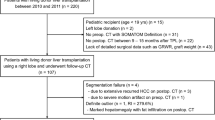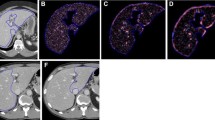Abstract
Purpose
To predict the rate of liver regeneration after living donor liver transplantation (LDLT) using pre-operative computed tomography (CT) texture analysis.
Materials and methods
112 living donors who performed right hepatectomy for LDLT were included retrospectively. We measured the volume of future remnant liver (FLR) on pre-operative CT and the volume of remnant liver (LR) on follow-up CT, taken at a median of 123 days after transplantation. The regeneration index (RI) was calculated using the following equation: \( [(V_{\text{LR}} - V_{\text{FLR}} )/V_{\text{FLR}} ]\, \times \,100 \). Computerized texture analysis of the semi-automatically segmented FLR was performed. We used a stepwise, multivariable linear regression to assess associations of clinical features and texture parameters in relation to RI and to make the best-fit predictive model.
Results
The mean RI was 110.7 ± 37.8%, highly variable ranging from 22.4% to 247.0%. Among texture parameters, volume of FLR, standard deviation, variance, and gray level co-occurrence matrices (GLCM) contrast were found to have significant correlations between RI. In multivariable analysis, smaller volume of FLR (ß − 0.17, 95% CI − 0.22 to − 0.13) and lower GLCM contrast (ß − 1.87, 95% CI − 3.64 to − 0.10) were associated with higher RI. The regression equation predicting RI was following: RI = 203.82 + 10.42 × pre-operative serum total bilirubin (mg/dL) − 0.17 × VFLR (cm3) − 1.87 × GLCM contrast (× 100).
Conclusion
Volume of FLR and GLCM contrast were independent predictors of RI, showing significant negative correlations. Pre-operative CT with texture analysis can be useful for predicting the rate of liver regeneration in living donor of liver transplantation.






Similar content being viewed by others
Abbreviations
- LDLT:
-
Living donor liver transplantation
- CT:
-
Computed tomography
- ROIs:
-
Regions of interest
- FLR:
-
Future liver remnant
- SD:
-
Standard deviation
- GLCM:
-
Gray-Level Co-occurrence Matrix
- ASM:
-
Angular second moment
- IDM:
-
GLCM inverse difference moment
- LR:
-
Liver remnant
- AIC:
-
Akaike information criteria
- VIF:
-
Variance inflation factor
- CIs:
-
Confidence intervals
References
Haga J, Shimazu M, Wakabayashi G, et al. (2008) Liver regeneration in donors and adult recipients after living donor liver transplantation. Liver Transpl 14:1718–1724
Taner CB, Dayangac M, Akin B, et al. (2008) Donor safety and remnant liver volume in living donor liver transplantation. Liver Transpl 14:1174–1179
Kim PT, Testa G (2016) Living donor liver transplantation in the USA. Hepatobiliary Surg Nutr 5:133–140
Broelsch CE, Burdelski M, Rogiers X, et al. (1994) Living donor for liver transplantation. Hepatology 20:49S–55S
Lee SY, Ko GY, Gwon DI, et al. (2004) Living donor liver transplantation: complications in donors and interventional management. Radiology 230:443–449
Hashikura Y, Ichida T, Umeshita K, et al. (2009) Donor complications associated with living donor liver transplantation in Japan. Transplantation 88:110–114
Kamel IR, Kruskal JB, Warmbrand G, et al. (2001) Accuracy of volumetric measurements after virtual right hepatectomy in potential donors undergoing living adult liver transplantation. AJR Am J Roentgenol 176:483–487
Emiroglu R, Coskun M, Yilmaz U, et al. (2006) Safety of multidetector computed tomography in calculating liver volume for living-donor liver transplantation. Transplant Proc 38:3576–3578
Joyeux H, Berticelli J, Chemouny S, Masson B, Borianne P (2003) Semi-automatic measurements of hepatic lobes. Application to study of liver volumes. Analysis of 50 computed tomography of normal liver. Ann Chir 128:251–255
Leelaudomlipi S, Sugawara Y, Kaneko J, et al. (2002) Volumetric analysis of liver segments in 155 living donors. Liver Transpl 8:612–614
Kim SJ, Kim DG, Chung ES, et al. (2006) Adult living donor liver transplantation using the right lobe. Transplant Proc 38:2117–2120
Hiroshige S, Shimada M, Harada N, et al. (2003) Accurate preoperative estimation of liver-graft volumetry using three-dimensional computed tomography. Transplantation 75:1561–1564
Kassner A, Thornhill RE (2010) Texture analysis: a review of neurologic MR imaging applications. AJNR Am J Neuroradiol 31:809–816
Tourassi GD (1999) Journey toward computer-aided diagnosis: role of image texture analysis. Radiology 213:317–320
Bayanati H, Thornhill RE, Souza CA, et al. (2015) Quantitative CT texture and shape analysis: can it differentiate benign and malignant mediastinal lymph nodes in patients with primary lung cancer? European Radiology 25:480–487
Ravanelli M, Farina D, Morassi M, et al. (2013) Texture analysis of advanced non-small cell lung cancer (NSCLC) on contrast-enhanced computed tomography: prediction of the response to the first-line chemotherapy. European Radiology 23:3450–3455
Ganeshan B, Abaleke S, Young RCD, Chatwin CR, Miles KA (2010) Texture analysis of non-small cell lung cancer on unenhanced computed tomography: initial evidence for a relationship with tumour glucose metabolism and stage. Cancer Imaging 10:137–143
Olthoff KM, Emond JC, Shearon TH, et al. (2015) Liver regeneration after living donor transplantation: adult-to-adult living donor liver transplantation cohort study. Liver Transpl 21:79–88
Boykov YY, Jolly M-P (2001) Interactive graph cuts for optimal boundary & region segmentation of objects in ND imagesComputer Vision, 2001 ICCV 2001 Proceedings Eighth IEEE International Conference on. IEEE, pp 105-112
Ger R (1989) Surgical anatomy of the liver. Surg Clin North Am 69:179–192
Chambolle A (2004) An algorithm for total variation minimization and applications. Journal of Mathematical imaging and vision 20:89–97
Zappa M, Dondero F, Sibert A, et al. (2009) Liver regeneration at day 7 after right hepatectomy: global and segmental volumetric analysis by using CT. Radiology 252:426–432
Sakamoto T, Ezure T, Lunz J, et al. (2000) Concanavalin A simultaneously primes liver hematopoietic and epithelial progenitor cells for parallel expansion during liver regeneration after partial hepatectomy in mice. Hepatology 32:256–267
Botha JF, Langnas AN, Campos BD, et al. (2010) Left lobe adult-to-adult living donor liver transplantation: small grafts and hemiportocaval shunts in the prevention of small-for-size syndrome. Liver Transpl 16:649–657
Davnall F, Yip CS, Ljungqvist G, et al. (2012) Assessment of tumor heterogeneity: an emerging imaging tool for clinical practice? Insights Imaging 3:573–589
Ganeshan B, Miles KA (2013) Quantifying tumour heterogeneity with CT. Cancer Imaging 13:140–149
Ju MK, Choi GH, Park JS, et al. (2012) Difference of regeneration potential between healthy and diseased liver. Transplant Proc 44:338–340
Kele PG, van der Jagt EJ, Gouw AS, et al. (2013) The impact of hepatic steatosis on liver regeneration after partial hepatectomy. Liver Int 33:469–475
Dello SA, Kele PG, Porte RJ, et al. (2014) Influence of preoperative chemotherapy on CT volumetric liver regeneration following right hemihepatectomy. World J Surg 38:497–504
Shimada M, Matsumata T, Maeda T, et al. (1994) Hepatic regeneration following right lobectomy: estimation of regenerative capacity. Surg Today 24:44–48
Kwon KH, Kim YW, Kim SI, et al. (2003) Postoperative liver regeneration and complication in live liver donor after partial hepatectomy for living donor liver transplantation. Yonsei Med J 44:1069–1077
Paluszkiewicz R, Zieniewicz K, Kalinowski P, et al. (2009) Liver regeneration in 120 consecutive living-related liver donors. Transplant Proc 41:2981–2984
Gaglio PJ, Liu H, Dash S, et al. (2002) Liver regeneration investigated in a non-human primate model (Macaca mulatta). J Hepatol 37:625–632
Greig JD, Krukowski ZH, Matheson NA (1988) Surgical morbidity and mortality in one hundred and twenty-nine patients with obstructive jaundice. Br J Surg 75:216–219
Scheingraber S, Bauer M, Bauer I, et al. (2009) Inhibition of hemoxygenase-1 improves survival after liver resection in jaundiced rats. Eur Surg Res 42:157–167
Cherqui D, Benoist S, Malassagne B, et al. (2000) Major liver resection for carcinoma in jaundiced patients without preoperative biliary drainage. Arch Surg 135:302–308
Das BC, Isaji S, Kawarada Y (2001) Analysis of 100 consecutive hepatectomies: risk factors in patients with liver cirrhosis or obstructive jaundice. World J Surg 25:266-272; discussion 272-263
Acknowledgements
We would like to thank Bonnie Hami, MA (USA) and Seunghyun Kim for her editorial assistance in the preparation of this manuscript.
Author information
Authors and Affiliations
Corresponding author
Ethics declarations
Conflict of interest
All authors confirm that no disclosure of potential conflicts of interest.
Ethical approval
This retrospective study was approved by our institutional review board, and the requirement to obtain written, informed consent was waived.
Appendix
Rights and permissions
About this article
Cite this article
Kim, JE., Kim, J.H., Park, S.J. et al. Prediction of liver remnant regeneration after living donor liver transplantation using preoperative CT texture analysis. Abdom Radiol 44, 1785–1794 (2019). https://doi.org/10.1007/s00261-018-01892-2
Published:
Issue Date:
DOI: https://doi.org/10.1007/s00261-018-01892-2




